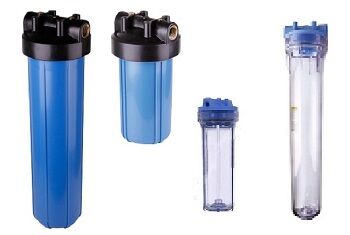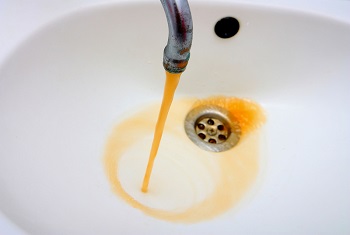You’ve been noticing some unpleasant odor in your water lately and you want to make sure that it’s not originating from your water softener. How can you sanitize your water softener? Can you simply put some bleach in your water softener to eliminate the odor?
You can put bleach in a water softener providing that you use the correct amount and type of bleach. Putting bleach in a water softener can help remove odor from your water and sanitize your water softener, but bleach can also cause damage to a water softener.
It is vital to only put bleach in a water softener in the correct way to prevent damage to the water softener resin and other parts inside of the water softener. Putting bleach in a water softener can help to sanitize the water softener, but only if done correctly.
Why Put Bleach In A Water Softener?
Putting bleach in your water softener can help to reduce odors coming from within the water softener and help eliminate or prevent bacteria growth inside of the system.
When you put bleach through a water softener, the bleach can help eliminate organic material that may cause odor in your water or cause your water to taste odd and even be unhealthy to drink from the inside of the water softener.
Bleach should not be put into a water softener as a salt alternative or for the purpose of improving your water softener’s overall performance.
Can Putting Bleach In A Water Softener Remove Odor From Your Water?

Only if the odor is coming from within the water softener!
Many people who discover an odor in their water immediately come to the conclusion that they can put some bleach in their water softener and that will remedy the problem.
The truth is, most odors that occur in water are likely in your water BEFORE it gets to your water softener or in the plumbing of your home AFTER it goes through your water softener.
Before you put bleach in your water softener in an attempt to remove odor from your water softener, we need to figure out if the odor is coming from your water softener or if it is in your water before your water goes through your water softener.
To determine if the odor is coming from your water softener, you can bypass your water softener and see if the odor goes away.
Most water softeners have a lever or levers, knob or knobs, a sliding valve, or a set of 3 levers that can be opened or closed to bypass your water softener which will stop your water from flowing through your water softener and instead send the water directly into your home.
If you bypass your water softener and find that the odor in your water remains the same, the odor is not coming from your water softener and is either coming from your water coming into your home or because of odor-causing bacteria in the plumbing of your home.
If you find that the odor from your water has gone away when your water softener has been bypassed, the odor is likely coming from inside your water softener and this is when you may want to put bleach in your water softener.
What Kind Of Bleach Should I Put In My Water Softener?
Only put standard household bleach in your water softener!
Do NOT put any of the following in your water softener!
- Scented bleach – Although scented bleach may sound like a great bleach to put in your water softener, the additives in it that make it smell nice can have a negative reaction with the water in your water softener.
- Low splash bleach – The additives used in low-splash bleach can cause damage to the water softener resin inside of your water softener.
- Swimming Pool Shock – Swimming pool shock can be as much as 4 times more potent than standard household bleach which could damage the water softener resin and internal parts of your water softener.
How Often Can You Put Bleach In A Water Softener?
The simple answer is:
“You should only put bleach in your water softener when needed!”
Even small amounts of chlorine contained in household bleach can cause damage to your water softener resin and internal parts so putting bleach in your water softener when there is no problem with your water is NOT recommended.
Only put bleach in your water softener if you are experiencing odors in your water that you have determined are coming from inside of your water softener or if the plumbing in your home needs to be sanitized because of bacteria growth.
When sanitizing the plumbing in your home, I recommend bypassing your water softener to protect the water softener resin from long-term exposure to chlorine.
Sanitizing your water softener separately from the rest of the plumbing in your home allows you to better control how much chlorine bleach goes into your water softener and how long it remains inside your water softener.
If you run chlorine bleach through the plumbing of your home and do not bypass your water softener, chlorine bleach could remain in the resin tank long enough to damage the resin.
How Much Bleach Should You Put In A Water Softener?
For the most common sizes of water softeners that you would most likely find in your home, ¼ – ½ cup (.059 – .118 liters) (depending on the size of your water softener) of common household bleach would be sufficient to thoroughly sanitize the inside of the water softener.
Using excessive chlorine bleach can damage the water softener resin and internal parts of a water softener.
How To Put Bleach In A Water Softener?
In order to properly sanitize your water softener using bleach, it is best to introduce the bleach to your water before your water goes into your water softener by putting the bleach into a water prefilter housing.
But if there is no prefilter housing before your water softener, you can also put bleach directly into the brine tank and have the water softener draw the bleach through the system.
It is important that the water softener resin does not remain exposed to chlorine bleach for an extended period of time. Prolonged exposure to chlorine can cause the resin to become damaged.
Two simple ways to sanitize your water softener using bleach
1. Pour diluted bleach into the water softener brine tank

Adding bleach to your water softener through the brine tank
The simplest way that I recommend to put bleach through your water softener is simply to pour a diluted dose of bleach directly into your water softener’s brine tank.
I recommend first creating a mix of ¼ – ½ of a cup (.059 – .118 liters) of household bleach to 1 gallon (3.78 liters) of water in a clean container. Then simply pour the mix into your water softener brine tank and manually start the water softener regeneration cycle.
By putting the bleach and water mix into your water softener brine tank, the water softener will draw the mixture into the water softener and then rinse it away after it has sanitized the inside of the water softener.
2. Put undiluted bleach into a water prefilter housing

Adding bleach to your water softener through a water prefilter housing
If your water softener has a water prefilter, you can remove the filter from the housing and add a dose of bleach into the housing, then put the housing back together and run the bleach through your water softener by turning on a water faucet in the home.
You will want to run the water faucet for several minutes (about 10 minutes should do the trick) to make sure that the bleach has gone through the water softener and then has been rinsed away.
You may or may not smell the bleach from the water faucet because the resin inside of the water softener can remove the chlorine from the water and the bleach may become too diluted for you to smell it.
After you are confident that all of the bleach has gone through the water softener and out of the faucet you can shut off your water, open the water filter housing and replace the filter cartridge.
If bleach is left in a water softener or your household plumbing, it could bleach your clothing when doing laundry or even get into your drinking water.
You have now run chlorine bleach through your water softener as well as the plumbing going from the water filter to the water faucet.
Can A Water Softener Get Damaged If You Put Bleach In It?
Common household bleach is a corrosive substance that can cause damage to many materials, especially metals. (Source)
Although many components of a water softener are made of plastic which is more resistant to chlorine bleach corrosion, there are many metal and rubber components of a water softener that can be damaged by common household chlorine bleach.
The chlorine in household bleach is especially corrosive to metal surfaces, causing etching and distortion of metal parts of a water softener after prolonged exposure.
Rubber seals inside of a water softener can become damaged by chlorine bleach and lose their ability to properly create a waterproof seal.
Water softener resin can expand as it absorbs chlorine from household bleach affecting water pressure and inhibiting the resin’s ability to remove hardness from your water.
You should NEVER leave bleach inside of your water softener as it can damage parts of the water softener over time.
Whenever you put bleach in a water softener, you should be sure to only run the bleach through the water softener and rinse away ALL of the bleach before putting the water softener back into service.
When Should You NOT Put Bleach In A Water Softener?
Generally, you should only put bleach in a water softener if you are getting an odor in your water that you have determined is coming from your water softener.
I highly recommend that you DO NOT put bleach in your water softener if you have any iron in your water.
Chlorine in household bleach can cause iron that is dissolved in your water to come out of your water and stain clothing, clog faucets and showerheads, and cause yellow staining on surfaces that come into contact with your water.

When iron is an issue in your water, you should consider using other water softener sanitization methods other than putting bleach in your water softener.
Is There A Better Alternative To Bleach To Sanitize A Water Softener?
The safest and most convenient way to sanitize a water softener without putting bleach in it is to use a water softener sanitizer that is specifically designed to easily sanitize the inside of a water softener without the potential problems that can occur when you put bleach in a water softener.
Water softener sanitizer is safe to use in your water softener, you can use it more often, it is very inexpensive and very easy to use.
Simply pour a dose of water softener sanitizer into your water softener’s brine tank, and that’s it!
To Sum Up!
You can put household bleach into a water softener to help remove odors that are coming from the inside of your water softener.
Do NOT use scented bleach, low-splash bleach, or swimming pool shock in a water softener.
Be sure to completely rinse away all of the bleach that you have put into your water softener to prevent damage to the water softener.
Using a water softener sanitizer is a safe and easy-to-use alternative to household bleach for removing odor originating inside of a water softener and sanitizing the inside of your water softener.



Greetings! I’ve been reading your website for some time now and finally got the bravery to go ahead and give you a shout out from Austin Texas! Just wanted to tell you keep up the good job!